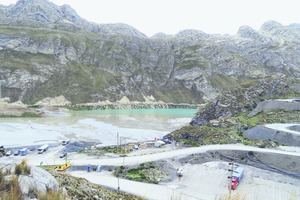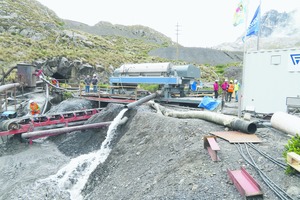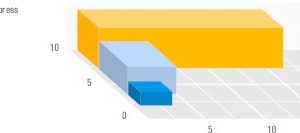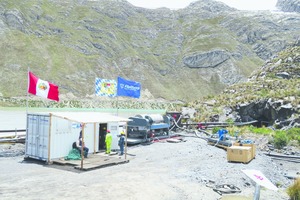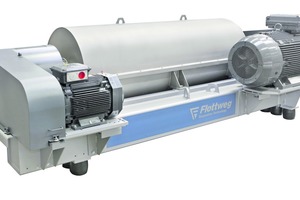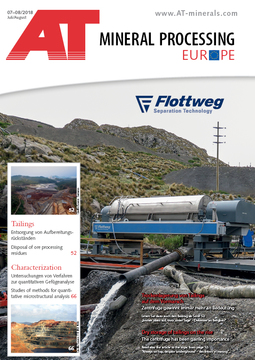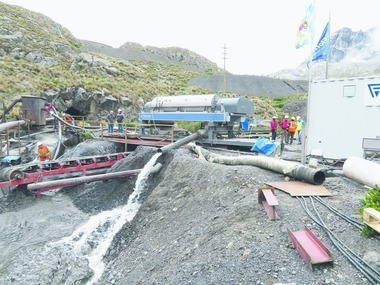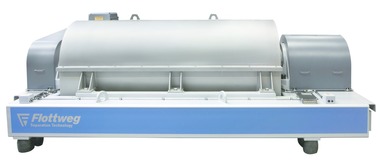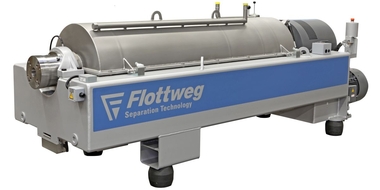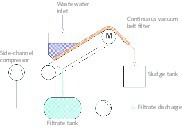Always on top, despite “underground” – decanters in mining
What are tailings?
In order to get to valuable minerals, mining companies move large amounts of rock. First it must be ground and then it is treated, usually with the addition of chemical solutions and large amounts of water. The lower the concentration of the valuable resources, the greater the proportion of accumulated excavated material sludge. These so-called tailings, which are partly still contaminated with chemicals, are pumped into large sludge basins. These basins are usually secured by earthworks. During mining, they must be stable enough to withstand the pressure of the stored excavated material. Unfortunately this is not always the case. The Baia Mara dam in Romania broke in 2000 and the Bento Rodrigues dam in Brazil broke on November 05, 2015, which cost 16 people their lives.
This storage option is still widely used, but has immense risks for the environment and binds the unused process water. In addition, there are tremendous costs for monitoring the dam stability and examining the groundwater contamination.
Dry storage of tailings on the rise
So-called dry storage is one alternative to this storage. During dry storage, the dried excavated material sludge is stored on the earth‘s surface. This disposal method is particularly reminiscent of modern and sealed embankments. This method requires much less space, is significantly safer and introduces the used process water directly back into the cycle. This method is clearly preferred, especially in hard-to-reach or constricted places with a high risk of earthquakes. In addition, many operators face the challenge that there are insufficient amounts of fresh water available in the mining regions, which has massive effects on the operational costs.
Dry storage is becoming increasingly popular due to economic calculations and the pressure from many governments. There are different methods to achieve this drying. In addition to the chamber filter press and the belt press, the centrifuge has been gaining importance in recent years.
Machines by comparison
The belt press is one option for drying trailings. Low-concentration sludge treated with polymeric flocculants is pumped into the product receptacle and evenly spread over a narrow-pore belt. The sludge on the belt is exposed to a vacuum from below in order to remove the liquid from the sludge.
Another option for dewatering the excavated material sludge is the chamber filter press. Filter presses are discontinuously working pressure filters for the solid-liquid separation of suspensions. Filter presses as apparatuses for cake filtration have a filter package formed by filter plates in a frame, which is arranged between a fixed lid and a movable lid. Filter media (fabric or membrane) is located between the individual filter plates. The fixed lid is connected to the bridge via connection and traction bar. The filter package is pressed via a hydraulic pressing device, which is integrated in the bridge and acts on the movable lid.
The pressing pressures are between 250 and 600 bar. The density of the filter package is ensured by these high pressures. The liquid passes through the filter media and leaves the press via drainage channels. The solid particles of the suspension remain back in the filter media and form the filter cake. After the filtration cycle is complete, the press is opened and the cake is removed. If this press does not do this automatically (self-cleaning chamber filter press), the pressure is slowly released, the filter press is opened and the cake is manually removed from the filter cloths. The filter cloths must be cleaned with washing liquid regularly, since they can clog over time.
However continuous systems, such as the decanter, can also allow for a drying of the excavated material sludge. With the decanter centrifuge, a liquid and a solid phase are separated from each other by centrifugal acceleration. The solid particles accumulate in the process due to the higher density at the bowl wall and are transported to the discharge openings with the help of a screw conveyor. At the same time, the clarified liquid flows along the screw into the liquid discharge zone.
The decanter is a fully automated and closed system. Large quantities of product can be processed with high selectivity. Special wear protection guarantees, for example, for decanters from the company Flottweg, guarantee low maintenance costs and low short downtimes.
Space and weight requirements
Mining or mining work is frequently located in remote places that are difficult to access. So it‘s a good thing when space can be saved. The following graphic uses a size comparison to illustrate the different dewatering systems with a hydraulic capacity of 100 m³/h and a total load of 20 000 kg.
However, the weights of the individual units also play a crucial role in the purchase decision:
Chamber filter press: 120 tons
Belt press: 65 tons
Centrifuge: 16 tons
Dewatering capacities
The capacities of the chamber filter press and the centrifuge are usually roughly the same. The centrifuge separates all particles larger than 5 micrometers. Polymeric flocculants must be used to be able to separate even smaller particles. These means must be used with the chamber filter press and the belt press anyway.
The centrifuge is also the only dewatering system to guarantee a consistent process. Deposits occur in the filter cloths and in the filter belt after some time both with the belt press as well as with the chamber filter press. This means that the draining capacity is reduced and the system has to be cleaned.
Case study at the end of the world
The Tiebaghi nickel mine in New Caledonia is located in mountainous terrain with very little water. These conditions as well as the fragile ecosystem in the region led to the mine operators placing high value on the recovery of process water.
The first contact between Flottweg, a separation technology specialist from Lower Bavaria, and the operators of the mine occurred in 2006. To date, the mine has consumed 650 000 m³ of fresh water per year. So the challenge was
to recycle the used water so it could be used again immediately.
After extensive testing and comparing the different dewatering units, the mine operators (the company Eramet) decided on decanter centrifuges from Flottweg. In just a few months, Flottweg installed eight Z92-4 decanters. The Z92 model is one of the largest decanter centrifuges in the world with a bowl diameter of 920 mm. The machines each process a throughput volume of 130 m³/h. The treated tailing sludge has a solids proportion of around 10 %. The operators are excited about the results. 98 % of the process water can be recovered every year this way. In addition, the operating company was able to get rid of costly dams, thus simultaneously ruling out the risk of a dam failure and the associated risk to people and nature.
Conclusion
The use of centrifuges is an excellent way to dry excavated material sludge or tailings. Expensive process water can be returned to the process within a very short period of time. The supply of fresh water can be reduced to a minimum. At the same time, the possibility of a dam failure is ruled out, which significantly reduces the risk to people and the environment.
Centrifuges require less fresh water and maintenance for dewatering and are also less expensive. Centrifuges are also significantly smaller, which makes it easier to use them in difficult-to-access areas.
The results from New Caledonia and other projects have demonstrated that dewatering tailings can be useful and cost-effective when the right dewatering system is chosen.
//www.flottweg.com" target="_blank" >www.flottweg.com:www.flottweg.com

